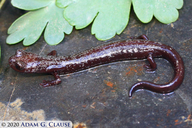|
Description
A large, robust member of its genus, identified by having four digits on the relatively long hind limb, by having a broad head well demarcated from the neck, and by having a relatively short body (16-18, mode 17, costal grooves). Perhaps the stockiest slender salamander; its proportions are more akin to those of Web-toed Salamanders (Genus Hydromantes). Unlike other Batrachoseps, it has NO DORSAL STRIPE and a SHORT TAIL, only about 3/4 as long as its body. It has a broad head and snout, and large eyes. These are sometimes dense enough to form a continuous network of silvery threads carpeting the entire dorsum. The limbs are long and when the limbs are adpressed to the body from 2 – 5 costal folds are uncovered. The ground color is dark brown-black with silvery patches on the head and and over the shoulders; in some populations the silvery pigmentation covers much of the dorsal surface of the trunk (photographs of living specimens in Marlow et al. 1979; and Yanev and Wake 1981).
Distribution and Habitat
Country distribution from AmphibiaWeb's database: United States U.S. state distribution from AmphibiaWeb's database: California
Known only from less than 15 localities scattered on both sides of the Inyo Mountains, between Owens Valley and Saline Valley, Inyo County, CA. The entire range is only about 15 km wide and 32 km long, and most of the terrain is unsuitable for salamanders. The species occurs in extremely xeric terrain which receives only about 22 cm of rainfall or less annually. Habitat described by Marlow et al. (1979).
Life History, Abundance, Activity, and Special Behaviors
The life history is a virtual mystery. It appears to be nocturnal, preferring the cover of moist rocks and dark crevices during daylight., or ecology.
This species was not discovered until the mid-1970’s and remains poorly studied in nature. It has been found mainly near permanent streams under small to large rocks, often on humic soil under cover objects. It has been found at all times of the year, and some individuals have been found in well-shaded, moist rock crevices distantly removed from permanent water. The rocks are limestone, and the salamanders may live mainly in subsurface habitats. Likely has direct developing young, like other species of Batrachoseps, but nothing is known of its reproductive habits.
Trends and Threats
Because of its restricted habitat, isolation, and probably small population size, any habitat alteration should be considered a threat.
The stream-side habitat of the species is severely limited in extent and the climate is exceptionally harsh (intensely hot and dry) for a terrestrial salamanders. Any habitat destruction in its limited range could threaten local populations.
Relation to Humans
Not known
Comments
Among described taxa this species is most closely related to Batrachoseps wrighti from Oregon and is only distantly related to described species from California
See another account at californiaherps.com.
References
Jennings, M. R., and Hayes, M. P. (1994). ''Amphibian and reptile species of special concern in California.'' Final Report #8023 Submitted to the California Department of Fish and Game. California Department of Fish and Game, Sacramento, California..
Marlow, R. W., Brode, J. M. and Wake, D. B. (1979). ''A new salamander, genus Batrachoseps, from the Inyo Mountains of California, with a discussion of relationships in the genus.'' Contributions in Science, Natural History Museum of Los Angeles County, (308), 1-17.
Yanev, K. P. and Wake, D. B. (1981). ''Genic differentiation in a relict desert salamander, Batrachoseps campi.'' Herpetologica, 37, 16-28.
Originally submitted by: Joshua R. Whorley (first posted 1999-03-14)
Edited by: David B. Wake (2021-03-17)Species Account Citation: AmphibiaWeb 2021 Batrachoseps campi: Inyo Mountains Salamander <https://amphibiaweb.org/species/3942> University of California, Berkeley, CA, USA. Accessed May 29, 2025.
Feedback or comments about this page.
Citation: AmphibiaWeb. 2025. <https://amphibiaweb.org> University of California, Berkeley, CA, USA. Accessed 29 May 2025.
AmphibiaWeb's policy on data use.
|




 Raffaëlli Account
Raffaëlli Account Map of Life
Map of Life